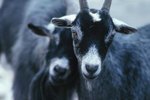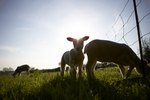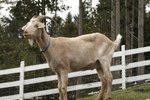Full-size dairy goats may stand as tall as 30 inches at the shoulder and weigh as much as 135 pounds. If you want to go smaller, breed options include Pygmy goats and Nigerian dwarf goats. While both get referred to as miniature goats, a miniature goat may also be the offspring of one of these two breeds and a full-size parent.
Breed Differences
Both Pygmy and Nigerian dwarf goats possess playful personalities. They both can be housed in a shed with access to a yard that has 4-foot-high fencing. The main differences between the two are in body shape and milk production.
Body Shape
Nigerian dwarf goats look like miniature versions of full-size dairy goats; they have elongated bodies and graceful necks, and pronounced abdominal tucks. Pygmies were originally bred for their meat. Specimens have stocky, wide bodies and short legs. They have barrel-shaped abdomens that give the impression of perpetual pregnancy. Instead of their abdomens narrowing as they near the flank, they increase in width and depth. Both breeds stand no more than 23 inches high at the shoulder.
Coloration
Nigerian dwarf goats may come in many colors and patterns. Some even have blue eyes. Pygmy goats are variations on black, grey, caramel and agouti; they have brown eyes.
Milk Production
Both Pygmy and Nigerian dwarf goats produce milk that is rich in butterfat, giving the milk a sweet taste. Pygmy milk ranges from 4.5 to 11 percent butterfat, while Nigerian dwarf milk averages 6 percent or greater. Both Nigerian dwarfs and Pygmy goats produce 1 quart to two-thirds of a gallon daily during lactation cycles. Nigerian dwarfs breed once a year, like full-size dairy goats, and can lactate for more than 300 days. Pygmy goats are polyestrous, meaning they can breed any time of year. For this reason, their lactation cycles are shorter, about 180 days. To harvest milk year-round, alternate lactation cycles in two or more does.
Mixed Miniatures and Dwarfism
Designer Goats
Nigerian dwarf or Pygmy goats crossed with full-size dairy goats produce crossbred miniature goats. These goats are taller than the maximum height of 23 inches for Pygmies and Nigerians but shorter than 30 inches. The Pygmies or Nigerian dwarfs may be bred to specimens of a dairy breed for milk production or angora specimens for fiber production.
True Dwarfs
Dwarfism can refer to a condition in any goat species due to genetics, illness or nutritional deficiencies. Some causes of dwarfism in goats include copper deficiency, hypothyroidism and pituitary problems. Before purchasing a dwarf or miniature goat, check the goat's lineage to avoid getting one with health problems.
Writer Bio
Indulging her passion for vacation vagary through the written word on a full-time basis since 2010, travel funster Jodi Thornton-O'Connell guides readers to the unexpected, quirky, and awe-inspiring.





